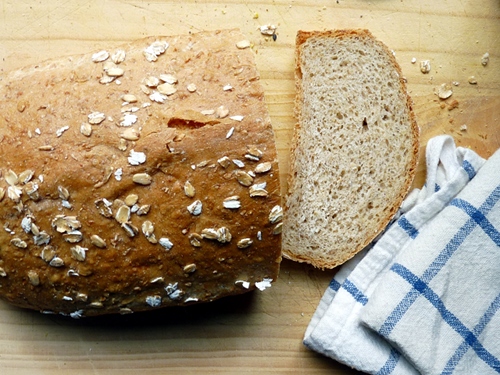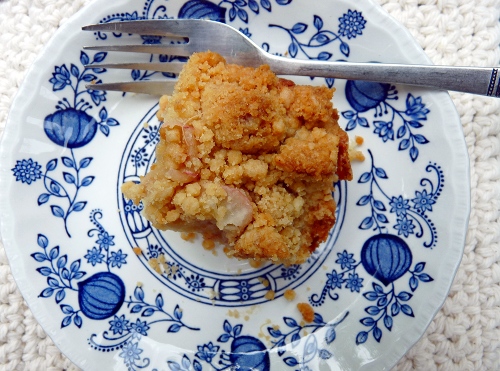Today’s blog post exists thanks to my husband Dan. He’s generally the cook in our kitchen while I love baking – except when it comes to bread. A couple of weeks ago he made two loaves of white sandwich bread from the same book mentioned below – Bernard Clayton’s New Complete Book of Breads – and we devoured them in three days. Notice I said two loaves…
I highly recommend the book – it’s quite the tome in fact, coming in at close to 700 pages and has a recipe for every kind of bread you could dream of, from classic white and wholewheat loaves of every variety to fruit and nut breads, cheese breads, French, Italian, sourdough, flatbread, crackers, brioche, croissants, festive breads, and everything in between. If you’re looking to get started with baking breads, this would be an excellent starting point.
This English oatmeal bread is just the kind of bread I love – a soft, pliable inside full of wholewheat nuttiness. The crust has that all-important crunch and the sprinkle of oats adds a lovely texture to each bite. Warm out of the oven with a swipe of butter, this stuff is completely irresistible.
English Oatmeal Bread
from Bernard Clayton’s New Complete Book of Breads
Ingredients
- 2 cups of oatmeal, plus two tbsp for dusting
- 2 cups milk
- 1 package dry yeast
- 2 tbsp butter at room temperature
- 2 tsp salt
- 1 cup wholewheat flour
- 2 cups bread flour
- 1 egg, beaten, mixed with 1 tbsp water
Directions
- In a large bowl soak the oatmeal in the milk for 2 hours.
- Stir the yeast into the oatmeal mixture; add the butter, salt, and wholewheat flour. Beat by hand for 100 strokes. Add 1/2 cup bread flour and continue beating for a few minutes longer.
- Stir in the rest of the bread flour, 1/2 a cup at a time, first with the spoon and then by hand. The dough will be a rough, shaggy mass that will clean the sides of the bowl. If, however, the dough continues to be slack or moist, and sticks to your fingers or work surface, sprinkle with additional flour.
- Turn the dough onto a lightly floured surface and knead with the rhythmic motion of push-turn-fold. The dough will become smooth and elastic. Occasionally change the kneading rhythm by raising the dough above the table and whacking it down hard against the surface. Knead by hand for about 8 minutes.
- Pulse the oatmeal in a food processor until mixed. Add the yeast, butter, salt, wholewheat flour, and 1/2 cup bread flour. Pulse 3 or 4 times to blend thoroughly. With the processor running, add the rest of the flour, 1/4 cup at a time, through the feed tube. (You might not need all the flour to form a mass – or you might need a little more – add the last portion with care.)
- When the dough becomes a rough ball and spins around the processor, take it out and knead it for a few minutes. If the dough is sticky then dust it with sprinkles of flour to help it form into a smooth ball.
- Place the dough in a mixing bowl and pat with buttered fingers to keep the surface from crusting. Cover the bowl tightly with plastic wrap and put aside at room temperature until it has risen to about twice its original size, 1 1/2 hours. It can also be tested by poking a finger in it – the dent remains when the dough has risen.
- Punch down the dough, turn it onto the work surface, and knead briefly to press out the bubbles.
- Divide the dough into two pieces with a knife. Shape into balls and let them rest under a towel for 3-4 minutes. Form each loaf by pressing a ball under your palms into a flat oval, roughly the length of the the baking pan (about a 7×3″ pan). Fold the oval in half, pinch the seam tightly to seal, tuck under the ends, and place in the pan, seam down.
- Cover the pans with wax paper and leave at room temperature until the centre of the dough has risen above the level of the edge of the pan, about 45 minutes.
- Brush the raised breads with egg wash and sprinkle with 2 tbsp oats.
- Preheat oven to 400F 2o minutes before baking. Bake in hot oven for 30 minutes, reduce heat to 350F, and continue baking for another 20 or 30 minutes, or until the loaves are a golden brown and test done. Turn one loaf out of its pan and tap the bottom crust with a finger. A hard, hollow sound means it is baked. If the loaves appear to be browning too quickly, cover with a piece of foil. Midway during baking, and again near the end of it, shift the pans so the loaves are exposed equally to temperature variations in the oven.
- Remove breads from oven and place on a wire rack to cool. Yields two loaves.







